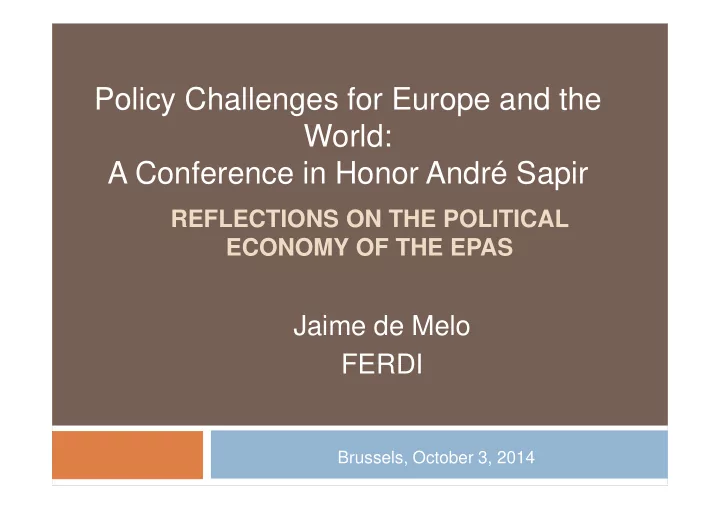

Policy Challenges for Europe and the World: A Conference in Honor André Sapir REFLECTIONS ON THE POLITICAL ECONOMY OF THE EPAS Jaime de Melo FERDI Brussels, October 3, 2014
Reflections on the Economic Partnership Agreements (EPAs) In light of excerpts from André Sapir “The Political Economy of EC Regionalism” European Economic Review, 1998 Did André’s analysis of the then EC’s political economy of Regionalism carry over to the EU’s just-conluded EPAs in October 2014? Excerpt #1 Remarks: ACP preferences were part the EC’s foreign policy. A succession to the Lomé convention expiring in 2000 was necessary but the EPA’s came in response to the EU’s desire to preserve ACP preferences (superior to GSP) for ACP countries not benefitting from EBA as required by the Doha Round of negotiations in 2001 where reciprocity became required in FTAs 2
Excerpt #2 Remarks: The jury is still out for RTAs among countries in SSA where external tariffs remain high and policy-imposed barriers to trade still remain. The Cotonou Parnership Agreement (CPA) set out the following elements: Differentiation : (not preserved). Because of the EU’s proliferation of FTA, the average preferential margin for African countries is only1 percentage point; Reciprocity : (only partial) Ensuring WTO-compatibility was accepted with 80% of imports liberalized Regionalism : (not achieved) Regional intergration within the ACPs groups (two-layer objective) was only achieved for CARIFORUM and the EAC; Development : EPAs are to be “economically meaningful, politically sustainable, and socially acceptable”. 3
Excerpt #3 Remarks: The same template was imposed across EPAs. • The only full EPA with Caribbean members signed in 2007 was hailed as a deep EPA but implementation so far has been disappointing: in effect ‘access without entry’, an MFN clause and tariff reductions only started for 6 members. • African EPAs did not go beyond ‘shallow’ integration in goods market stretching over long periods of time (often around 20 years).
Excerpt #4 (in relation to the EA agreements) Remarks: No additional constraints or incentives were provided to induce countries to carry out the reforms envisaged in the CPA in 2002. A reduction of 20% in the allocation of funds for the 11 th EFF • • African EPAs did not go beyond ‘shallow’ integration in goods market stretching over long periods of time (often around 20 years).
Excerpt #5 Remarks: This remark by André as a partial explanation for the lack of uptake of preferences in FTAs has been vindicated in QUAD-led FTAs where North-South FTAs have amounted to “giving with one hand (preferences) and taking away wit the other (costly to comply Rules of Origin)” EAC-EU protocol 78 pages long but list of proposed RoO was 180 pages long ! • In the final stages of the EAC negotiations were still active on a list of 370 Product- • Specific Rules of origin (tougher for the EU for 70 products and tougher for the EAC on 4). • Expected loss of tariff revenue from the EAC over the 20-year adjustment period: Around 3% of tariff revenue when computed from customs data taking into account tariff exemptions (and around 10% with no exemptions)
Summary The EPAs negotiations were a side-show in EC foreign policy with non- implemented development objectives. • Twelve years of negotiations will have ended up preserving EU market access for non-LDC African members, preferences worth about 1 percentage point after adjusting for the preferences the EU accords to other trading partners. • Minimal reduction in tariffs on goods trade accompanied by extremely long time tables (often exceeding twenty years), exception lists excluding goods with high protection. • Negotiations under the ‘rendez-vous clause’ will have revolved around inclusion of an MFN clause and the exclusion of export taxes in bilateral trade with the EU, both narrowing the policy space for African EPA members. � The initial CPA objective of contributing to the deepening of regional integration in Africa along ‘development-friendly’ lines has not been met.
References Melo, J. de and J. Regolo (2014) “The African Economic Partnership Agreements wit the EU: Reflections Inspired by the case of the East African Community”, Journal of African Trade (forthcoming) Sapir, A. “The Political Economy of EC Regionalism”, European Economic Review , 42 , 717-32 Melo and Regolo (2014) “The EU’s Economic Partnership Agreements (EPAs) sideshow is coming to a close” VOX column http://www.voxeu.org/article/eu-trade-deals-developing-nations-missed- opportunities 8
Recommend
More recommend